This is the professional version of my USB galvanic isolator for USB interface/board in 105/105D. The USB board it need its own 5v PSU when using this digital isolator.
There is an option here to chose either the coax in or the optical in in addition to the USB in. I appreciate that the coax in and optical in are in this case redundant (as these are galvanic isolated as concept), and however are lower quality than the USB one...
There is an option here to chose either the coax in or the optical in in addition to the USB in. I appreciate that the coax in and optical in are in this case redundant (as these are galvanic isolated as concept), and however are lower quality than the USB one...
Attachments
I have 3,3Vpp on XLR outputs, instead of 5-6Vpp (active stage). This is not so big problem, as this almost 3dB level lose it can be easily compensated by the amplifier.
For example, I don't use XLR output.
Is it possible to switch it off and combine the negative and positive outputs of es9018, dedicated to RCA and XLR, together to have more current and voltage on RCA?
I may only say (as a conclusion about the many mods on this device in a quite long time), that the quality of the power system seems to be CRUCIAL to get this player performances to an incredible high level.
The linear (analogue) PSU approach to power the digital stage of the device (of a device...) is a very clever idea. Even thought it may look a little bit stupid in a first instance... I was myself sceptical in the beginning about such approach, and I see now that I was very wrong! There is of course not that simple to only connect a whatsoever linear PSU to the main board, and that`s it. Well, there may be some improvements so, but the real and exceptional improvements, it come from the quality of the power provided by that analogue PSU/LPM.
My last result in improvements is enough difficult for myself to believe it. There is (as overall) about huge increasing the reproduced bandwidth, as also huge improvements for the sound-scene. A such sound-scene I never thought it is possible to have, but I was always looking for actually. Extreme precision of the sound elements in space. I never imagine, and I never before heard such richness and fine details in the sound engineering of an old Vangelis record. Moreover, all these just playing back a simple CD at 44,1khz/16bit, in the BD driver. From very close sound sources (I suppose it was about speakers used at the record session), it is possible to perceive the direction these sounds goes to in the environmental space. I was never before listening of a such richness in so fine details when playing back a recording (an enough old one). I considered these my old recordings transposed on CD, as enough bad quality, comparing with the last modern ones. I never played these back for years, from the original support, considering as low and non-satisfactory quality (in my opinion). I am very surprised now to experience my very wrong previous appreciations. These CDs it sounds actually exceptional…
There is a very old recording from Iron Butterfly - In a Gadda Da-Vida, which it include a quite long drums solo. This solo it sounds like a simple sound effect on a usual playback device. That sound effect (heterodyne sounding like), is in fact a very interesting one: the sound is moving actually around, in space, from right, in front, to left, then in the back of the sound-scene, coming back again in initial place. I was very impressed by the fine engineering of such old record, with quite poor technological means of that time. Well, how they did then, it was very well and extremely precise reproduced by this my (heavily now) moded 105...
Well, these above examples, and these results I got on my device, I cannot say it come exclusively from the improved power system. There is for sure an overall result. However, in my case, and after heaving in place all other possible improvements, the last one improvement on my LPM and the rest of the power system, it looks like it came as the last puzzle piece in its right place...
After I will have the new version of my LPM finished, I will come back with some more technical details.
The linear (analogue) PSU approach to power the digital stage of the device (of a device...) is a very clever idea. Even thought it may look a little bit stupid in a first instance... I was myself sceptical in the beginning about such approach, and I see now that I was very wrong! There is of course not that simple to only connect a whatsoever linear PSU to the main board, and that`s it. Well, there may be some improvements so, but the real and exceptional improvements, it come from the quality of the power provided by that analogue PSU/LPM.
My last result in improvements is enough difficult for myself to believe it. There is (as overall) about huge increasing the reproduced bandwidth, as also huge improvements for the sound-scene. A such sound-scene I never thought it is possible to have, but I was always looking for actually. Extreme precision of the sound elements in space. I never imagine, and I never before heard such richness and fine details in the sound engineering of an old Vangelis record. Moreover, all these just playing back a simple CD at 44,1khz/16bit, in the BD driver. From very close sound sources (I suppose it was about speakers used at the record session), it is possible to perceive the direction these sounds goes to in the environmental space. I was never before listening of a such richness in so fine details when playing back a recording (an enough old one). I considered these my old recordings transposed on CD, as enough bad quality, comparing with the last modern ones. I never played these back for years, from the original support, considering as low and non-satisfactory quality (in my opinion). I am very surprised now to experience my very wrong previous appreciations. These CDs it sounds actually exceptional…
There is a very old recording from Iron Butterfly - In a Gadda Da-Vida, which it include a quite long drums solo. This solo it sounds like a simple sound effect on a usual playback device. That sound effect (heterodyne sounding like), is in fact a very interesting one: the sound is moving actually around, in space, from right, in front, to left, then in the back of the sound-scene, coming back again in initial place. I was very impressed by the fine engineering of such old record, with quite poor technological means of that time. Well, how they did then, it was very well and extremely precise reproduced by this my (heavily now) moded 105...
Well, these above examples, and these results I got on my device, I cannot say it come exclusively from the improved power system. There is for sure an overall result. However, in my case, and after heaving in place all other possible improvements, the last one improvement on my LPM and the rest of the power system, it looks like it came as the last puzzle piece in its right place...
After I will have the new version of my LPM finished, I will come back with some more technical details.
Last edited:
New LPM - Double layers filtering caps (DLC)
Well, finally I have my new version LPM assembled and running (fine).
The main improvement for this version LPM is its filtering stage, both pre and post regulator device. I decided to use for this version the dissipation through the device chassis. This is not because I want to remove the fan from this approach, but I realised that the heat removing it may be more efficient so. I strongly recommend the use of an active ventilation in 105 models, as the internal temperature it rise quite much, even though the heat it dissipate this way.
There is best all points of view to keep inside the enclosure at lower temperature as possible.
I have also integrated in this new version, a regulator more for the isolated USB interface. The R core transformer it will deliver power for this regulator too.
The PCB of this LPM version is now designed to fit all the Oppo players’ models, including the old ones, as the newest 101. For 101, as for 103 models my LPM it will be able to deliver too the +/- 15v rails. A module including these regulators it will be attached to the main board in the same dimensional footprint.
Herby are also some measurements screenshots. Please compare it with the previously published ones for a comparative appreciation.
As one can see in these screenshots, the max ripple noise at full load, do not exceed 1µV. Full load it mean 5A on 5v rail, 800mA on +15v rail, 200mA on USB output, and a running fan. All this from a 50w transformer...
In this chassis dissipation approach, the 5v regulator it have no more than 50 deg. C on its body, and the chassis it reach 43 deg. C in the LPM area (with spinning hard disk attached on USB). With enclosure closed, and without ventilation, the inside temperature it goes over 46 deg. C. With active ventilation, the player it work at room temperature.
As I previously mentioned, I use in this power supply a new concept for filtering, after I have played with these large capacities caps for a while, in similar approaches, but more as decoupling devices (near to the targeted component). If the double layer caps as (PSU) filtering caps is not something new, then please let me know...
We have in today technology, these devices capable to store enormous amount of energy, so why not using it to filter out and accumulate (buffering) the energy in a DC PSU?
Well, not all such type caps may fit to this application, but carefully chosen it, and using it accordingly (by design), the result is pure and simple, only positive.
As the measurements it shows, the differences may not be very important comparing it with a PSU with classic filtering caps of a reasonable total capacity. I obtained 3µV ripple with the previous LPM version, and now I have max 1µV. The difference is small in measurements, but is huge for the overall system functionality and the outputted results (in this case, Oppo player and its digital stage).
The main issue with large conventional capacities is the very big dimensions for such PSU. These double layers caps are very small for their extreme capacity capabilities.
My LPM it use for the 5v rail a total of almost 2F, while the 15v rail it have around 0,3F…
The installation is quite simple. A one mm thick silicone thermal pad it do the heat transfer. I would like to use the regulators thermal connected directly to the chassis, through thinner thermal pads. The 3D shaped bottoms of the chassis do not allow such approach, so I use the same heatsink as before, for a large heat transfer area. Quite efficient…
This PSU approach it will allow now easier the use of the multichannel board for 105 models..
Well, finally I have my new version LPM assembled and running (fine).
The main improvement for this version LPM is its filtering stage, both pre and post regulator device. I decided to use for this version the dissipation through the device chassis. This is not because I want to remove the fan from this approach, but I realised that the heat removing it may be more efficient so. I strongly recommend the use of an active ventilation in 105 models, as the internal temperature it rise quite much, even though the heat it dissipate this way.
There is best all points of view to keep inside the enclosure at lower temperature as possible.
I have also integrated in this new version, a regulator more for the isolated USB interface. The R core transformer it will deliver power for this regulator too.
The PCB of this LPM version is now designed to fit all the Oppo players’ models, including the old ones, as the newest 101. For 101, as for 103 models my LPM it will be able to deliver too the +/- 15v rails. A module including these regulators it will be attached to the main board in the same dimensional footprint.
Herby are also some measurements screenshots. Please compare it with the previously published ones for a comparative appreciation.
As one can see in these screenshots, the max ripple noise at full load, do not exceed 1µV. Full load it mean 5A on 5v rail, 800mA on +15v rail, 200mA on USB output, and a running fan. All this from a 50w transformer...
In this chassis dissipation approach, the 5v regulator it have no more than 50 deg. C on its body, and the chassis it reach 43 deg. C in the LPM area (with spinning hard disk attached on USB). With enclosure closed, and without ventilation, the inside temperature it goes over 46 deg. C. With active ventilation, the player it work at room temperature.
As I previously mentioned, I use in this power supply a new concept for filtering, after I have played with these large capacities caps for a while, in similar approaches, but more as decoupling devices (near to the targeted component). If the double layer caps as (PSU) filtering caps is not something new, then please let me know...
We have in today technology, these devices capable to store enormous amount of energy, so why not using it to filter out and accumulate (buffering) the energy in a DC PSU?
Well, not all such type caps may fit to this application, but carefully chosen it, and using it accordingly (by design), the result is pure and simple, only positive.
As the measurements it shows, the differences may not be very important comparing it with a PSU with classic filtering caps of a reasonable total capacity. I obtained 3µV ripple with the previous LPM version, and now I have max 1µV. The difference is small in measurements, but is huge for the overall system functionality and the outputted results (in this case, Oppo player and its digital stage).
The main issue with large conventional capacities is the very big dimensions for such PSU. These double layers caps are very small for their extreme capacity capabilities.
My LPM it use for the 5v rail a total of almost 2F, while the 15v rail it have around 0,3F…
The installation is quite simple. A one mm thick silicone thermal pad it do the heat transfer. I would like to use the regulators thermal connected directly to the chassis, through thinner thermal pads. The 3D shaped bottoms of the chassis do not allow such approach, so I use the same heatsink as before, for a large heat transfer area. Quite efficient…
This PSU approach it will allow now easier the use of the multichannel board for 105 models..
Attachments
-
 New%20LPM%20-%20some%20measurements_zpszugddloe.jpg92.3 KB · Views: 137
New%20LPM%20-%20some%20measurements_zpszugddloe.jpg92.3 KB · Views: 137 -
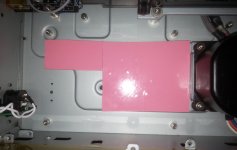 thermal%20pard_zpscrgyqysd.jpg384.4 KB · Views: 158
thermal%20pard_zpscrgyqysd.jpg384.4 KB · Views: 158 -
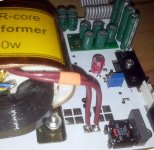 Double%20layer%20filtering%20caps_zpsy21kfev5.jpg662.6 KB · Views: 152
Double%20layer%20filtering%20caps_zpsy21kfev5.jpg662.6 KB · Views: 152 -
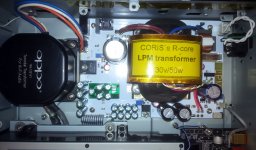 New%20LPM%20in%20place_zpslrdpln1g.jpg530.1 KB · Views: 268
New%20LPM%20in%20place_zpslrdpln1g.jpg530.1 KB · Views: 268 -
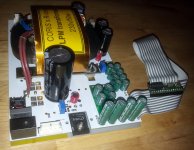 New%20LPM%20version%20-%20DLC%202_zpsac2tr3jc.jpg618.1 KB · Views: 271
New%20LPM%20version%20-%20DLC%202_zpsac2tr3jc.jpg618.1 KB · Views: 271 -
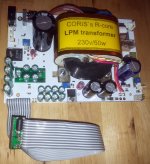 New%20LPM%20version%20-%20DLC%201_zpscek6pcv2.jpg803.2 KB · Views: 288
New%20LPM%20version%20-%20DLC%201_zpscek6pcv2.jpg803.2 KB · Views: 288 -
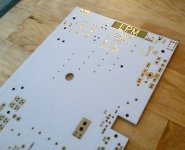 newLPM_zpsyrgdqhad.jpg681.1 KB · Views: 297
newLPM_zpsyrgdqhad.jpg681.1 KB · Views: 297
Last edited:
Very nice and top-notch quality work Coris. Really excellent work. Congratulations!
Do you have larger photo sizes for the Keysight plots? We'd like to see how clean the noise lines are ...though the bottom FFT plots behave as expected.
Are your boards for sale? If so, how much?
How easy to difficult are they to install in the Oppo 105? Do you have to remove/desolder lots of stuff in the Oppo to have space for your power supply?
Do you have larger photo sizes for the Keysight plots? We'd like to see how clean the noise lines are ...though the bottom FFT plots behave as expected.
Are your boards for sale? If so, how much?
How easy to difficult are they to install in the Oppo 105? Do you have to remove/desolder lots of stuff in the Oppo to have space for your power supply?
Last edited:
Thanks for your appreciations.
Indeed, the measurement picture is not big enough. It is the site which host these pictures which it lowered so...
Here is a bigger picture.
There is not about to solder/unsolder anything when to install this LPM. One should disconnect and then unscrew the older board (first its cover), remove the black original plastic foil, place the thermal pads as in the picture here, then put in place the LPM, screw back some screws, and connect the connectors. Then Power On...
This PSU it fit in the place of the original one (now for all the Oppo BD player models.
For another details, please check your PM...
Please remark that this PSU is meant to power a very noisy stage/system as the digital one it is. Therefore, there is not the most important its lowest noise figures. However comparing a linear PSU with a SMPS, one realise at once the huge differences, when about noise levels...
I published this plots more as a reference. The LPM is loaded here resistively. This version it have even lower noise/ripple figures. However, when connected to the digital system, the noises measured on its output rails increase dramatically. This is very normal and expected. In spite all this, when using a linear (low noise) PSU to power a digital stage, the overall functionality and the final result of the digital processing is also dramatically improved. In this case is about the picture and sound quality at the device output. What in details it really happen, it have to be explained, and this it may be a huge discussion subject.
My meaning with this improvement, upgrade, tweak, is not to find the explanations, but to enjoy the factual result.
A very low noise PSU it have a strong meaning when to use such for an analogue stage, as an audio signal processing may be. This LPM as it is, may not be very appropriate to be used in a such area, and it is not meant at all for this purpose. When use it on a digital system it just improve a lot the processing quality. As I said, the ripple level it may not be very important for this my new version LPM, but using these extreme large capacities for filtering and accumulation (or as energy buffer), it improve even more the result of the digital processing. I`m not very sure this is because the lower ripple level. It could be nice to try together to find out what kind of mechanisms it works in such case... Personally I have some theories about what may happen, but about these with another occasions...
Well, some more of my considerations in on this subject...
Indeed, the measurement picture is not big enough. It is the site which host these pictures which it lowered so...
Here is a bigger picture.
There is not about to solder/unsolder anything when to install this LPM. One should disconnect and then unscrew the older board (first its cover), remove the black original plastic foil, place the thermal pads as in the picture here, then put in place the LPM, screw back some screws, and connect the connectors. Then Power On...
This PSU it fit in the place of the original one (now for all the Oppo BD player models.
For another details, please check your PM...
Please remark that this PSU is meant to power a very noisy stage/system as the digital one it is. Therefore, there is not the most important its lowest noise figures. However comparing a linear PSU with a SMPS, one realise at once the huge differences, when about noise levels...
I published this plots more as a reference. The LPM is loaded here resistively. This version it have even lower noise/ripple figures. However, when connected to the digital system, the noises measured on its output rails increase dramatically. This is very normal and expected. In spite all this, when using a linear (low noise) PSU to power a digital stage, the overall functionality and the final result of the digital processing is also dramatically improved. In this case is about the picture and sound quality at the device output. What in details it really happen, it have to be explained, and this it may be a huge discussion subject.
My meaning with this improvement, upgrade, tweak, is not to find the explanations, but to enjoy the factual result.
A very low noise PSU it have a strong meaning when to use such for an analogue stage, as an audio signal processing may be. This LPM as it is, may not be very appropriate to be used in a such area, and it is not meant at all for this purpose. When use it on a digital system it just improve a lot the processing quality. As I said, the ripple level it may not be very important for this my new version LPM, but using these extreme large capacities for filtering and accumulation (or as energy buffer), it improve even more the result of the digital processing. I`m not very sure this is because the lower ripple level. It could be nice to try together to find out what kind of mechanisms it works in such case... Personally I have some theories about what may happen, but about these with another occasions...
Well, some more of my considerations in on this subject...
Attachments
Last edited:
Thanks for the response Coris. Did you have the scope at the maximum vertical sensitivity scaling? If so ,one should be able to see the noise spikes more fully.
I guess you've already covered up the player but do you have any scope pics with the Oppo running actual loads digital and not resistive ones? It would also be nice to compare the scope pics of the original digital SMPS noise as compared toy our new linear PS.
No PM as of yet...
- David
I guess you've already covered up the player but do you have any scope pics with the Oppo running actual loads digital and not resistive ones? It would also be nice to compare the scope pics of the original digital SMPS noise as compared toy our new linear PS.
No PM as of yet...
- David
Hi David
Please take a look at these plots. It are a little bit old, and are about the previous version of my LPM. I had not time right now to do extended measurements on this new version. At least there is enough obvious for me that it perform better than the old version. I will do it for sure in the near future some more detailed measurements, because I`m interested too to find some explanations about what it happen here.
As you can see in these old plots, there are huge differences in the power quality delivered by a SMPS and a linear PSU. The designers it thought for sure, as I did for long time, that it no matter very much the noise level from a power supply which is meant to power a digital system. And more, there are commercial reasons for using at a so large scale these SMPS devices. However, it matters this noise level, when to come into a already noisy system. It just add even more, and it disturb the fine processes there. HF noises which it may come through power rails, it mean quite much for a digital processing...
As a anecdote, I can say that this scope I own, and use (original an Agilent one), it had a SMPS which generated a noise level of 1,4Vpp, over the DC rail. In the beginning, I was enough frustrated that I could not go lower to measure under 4mV, because the overall high noise level it not allowed that. This it happened on a brand new bought scope (this my scope). I investigated closer the problem, and I found this SMPS used by former Agilent in their measurement devices (specified for measurements lower than 1mV).
I decided to replace that b*** s*** SMPS with a linear PSU. And I showed (written) all about in a thread on Agilent forum (now Keysight ). I can only tell you that it was a lot of "noise" out of that thread... Finally, my scope could measure very well at its lowest specified level, and the overall noise it decreased dramatically, after this improvement.
So, this subject it may not be very new...Todays there are used SMPS in every single whatsoever device... Even in these audio (high end/quality) ones... They prefer to design and create new chips to clean the sound and picture, by sophisticated filtering and processing (Darbee, Dirac, etc) than do a such simple action, as replacing that inappropriate SMPS (at least for measurement and audio devices), with a enough simple but linear PSU...
The supporters of SMPSes may argue that the noises can be filtered out. It is not, pure an simple possible to get completely rid of that.
With a linear PSU, the digital system and the processing it perform quite different, at another quality. This is a fact now in my opinion.
Please take a look at these plots. It are a little bit old, and are about the previous version of my LPM. I had not time right now to do extended measurements on this new version. At least there is enough obvious for me that it perform better than the old version. I will do it for sure in the near future some more detailed measurements, because I`m interested too to find some explanations about what it happen here.
As you can see in these old plots, there are huge differences in the power quality delivered by a SMPS and a linear PSU. The designers it thought for sure, as I did for long time, that it no matter very much the noise level from a power supply which is meant to power a digital system. And more, there are commercial reasons for using at a so large scale these SMPS devices. However, it matters this noise level, when to come into a already noisy system. It just add even more, and it disturb the fine processes there. HF noises which it may come through power rails, it mean quite much for a digital processing...
As a anecdote, I can say that this scope I own, and use (original an Agilent one), it had a SMPS which generated a noise level of 1,4Vpp, over the DC rail. In the beginning, I was enough frustrated that I could not go lower to measure under 4mV, because the overall high noise level it not allowed that. This it happened on a brand new bought scope (this my scope). I investigated closer the problem, and I found this SMPS used by former Agilent in their measurement devices (specified for measurements lower than 1mV).
I decided to replace that b*** s*** SMPS with a linear PSU. And I showed (written) all about in a thread on Agilent forum (now Keysight ). I can only tell you that it was a lot of "noise" out of that thread... Finally, my scope could measure very well at its lowest specified level, and the overall noise it decreased dramatically, after this improvement.
So, this subject it may not be very new...Todays there are used SMPS in every single whatsoever device... Even in these audio (high end/quality) ones... They prefer to design and create new chips to clean the sound and picture, by sophisticated filtering and processing (Darbee, Dirac, etc) than do a such simple action, as replacing that inappropriate SMPS (at least for measurement and audio devices), with a enough simple but linear PSU...
The supporters of SMPSes may argue that the noises can be filtered out. It is not, pure an simple possible to get completely rid of that.
With a linear PSU, the digital system and the processing it perform quite different, at another quality. This is a fact now in my opinion.
Attachments
-
 LPM rails while HD on USB and CD playback.jpg479.9 KB · Views: 77
LPM rails while HD on USB and CD playback.jpg479.9 KB · Views: 77 -
 LPM - new measurements.jpg726.4 KB · Views: 274
LPM - new measurements.jpg726.4 KB · Views: 274 -
 LPM in action.jpg441.9 KB · Views: 293
LPM in action.jpg441.9 KB · Views: 293 -
 Original SMPS with improved final cap filtering.jpg696.8 KB · Views: 319
Original SMPS with improved final cap filtering.jpg696.8 KB · Views: 319 -
 LPM ripple on 5v and 15v rails.jpg484.8 KB · Views: 332
LPM ripple on 5v and 15v rails.jpg484.8 KB · Views: 332 -
 Serial PSU connected to the system - 5v rail.jpg643.1 KB · Views: 84
Serial PSU connected to the system - 5v rail.jpg643.1 KB · Views: 84
Last edited:
- Home
- Source & Line
- Digital Source
- Oppo's BDP105 - discussions, upgrading, mods...

